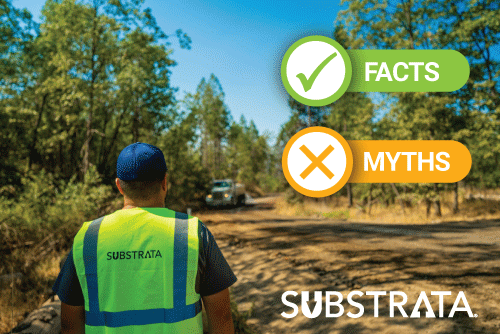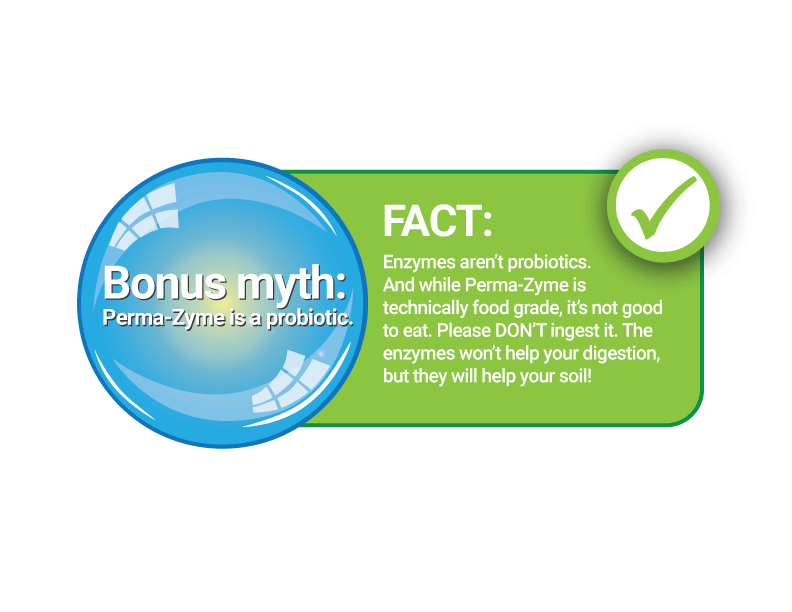
Before you choose a soil stabilizer for your project, it’s smart to know what that product can and can’t do. After all, nobody likes surprises when it comes to soil stabilization!
In this article, we’ll debunk the top seven myths about Perma-Zyme so you can better understand what this product is, what it can do for you, and how you can use it.
Let’s get started.
Fact: Perma-Zyme makes your unpaved road mostly smooth.
Perma-Zyme creates a hard, concrete-like surface that lasts for 10+ years with little to no maintenance. When people hear that, they often think the treated soil will be as smooth as a typical paved road.
However, an unpaved road is still unpaved. It will have some surface imperfections and loose material on top. It will still look and feel like dirt or gravel because it is.
With proper application, treating an unpaved road with Perma-Zyme creates a mostly smooth surface that’s free of hazards like washboarding, rutting, and potholes. That means fewer accidents, less vehicle damage, and less time and money to maintain the road.
To sum it up, unpaved roads won’t be perfectly smooth. But Perma-Zyme will make them smoother, safer, longer-lasting, and more cost-effective to maintain.
Fact: Perma-Zyme significantly reduces dust.
Mixing Perma-Zyme into soil bonds the soil particles together so they can’t escape into the atmosphere. That dramatically reduces the amount of dust.
You’ll still see a minimal amount of dust after using Perma-Zyme because dust doesn’t just come from the road. Wind and vehicles can still carry it onto treated surfaces from nearby areas like ditches and driveways. Once those particles get onto the road and you drive over them, that can create dust.
To further reduce dust, you can consider applying Surfa-Zyme, our enzyme-based dust suppressant that’s safe for the environment.
Fact: Perma-Zyme’s dilution rate depends on your soil type and climate.
There’s no set dilution rate for Perma-Zyme because how much Perma-Zyme you need doesn’t change how much water you need.
One gallon of Perma-Zyme always treats 160 cubic yards of soil. However, dilution depends on how much moisture the native soil contains. Here’s an example to help you see what we mean:
Both Jeff and Mark want to treat a mile of unpaved road, so they each need 15 gallons of Perma-Zyme. The amount of Perma-Zyme is the same because they’re treating the same size area.
Use our handy calculator to determine how much Perma-Zyme you need for your project.
The difference is the water.
Jeff and Mark each need their soil to reach its optimum moisture content because that’s when soil compacts properly.
Jeff’s road is in Georgia, where the humid climate helps keep native soil moist. Mark’s road is in Nevada, where the hot, arid climate dries out the soil.
Because Jeff’s soil is naturally wetter, he’ll need less water to achieve optimum moisture than Mark. That means Jeff’s dilution rate will be lower, and Mark’s dilution rate will be higher.
Generally, you can expect a higher dilution rate in hot, dry climates than in humid, cool climates.
Fact: Perma-Zyme is an enzyme-based soil stabilizer.
Enzymatic soil stabilizers are different than polymers.
Polymers work like glue. They hold soil particles together, but when the polymer breaks down, those soil particles separate, too.
Perma-Zyme works differently. Its enzymes react chemically with clay particles in the soil. The particles then bond to each other—not the enzyme.
This forms a hard, concrete-like surface that can last over 10 years without reapplication, saving you time and money on maintenance.
Fact: You should work Perma-Zyme into the soil for optimal results.
When you thoroughly work Perma-Zyme into the soil, the enzymes create more chemical reactions with the soil’s clay particles. This cures the soil more effectively to create a strong, concrete-like surface.
For roads with light vehicle traffic, like cars and pickup trucks, we recommend working Perma-Zyme into the soil four to six inches deep. For heavy traffic like dump trucks, log haulers, or machinery, we recommend a depth of nine to 12 inches.
It’s important to note that you can apply Perma-Zyme topically in some cases.
Topically apply Perma-Zyme before you pave a road. Thoroughly mix Perma-Zyme into the subbase to the recommended depth (above). Then, mix about 12 ounces of Perma-Zyme into a full water truck and spray the subbase to help the chipseal adhere better. We call this a sweet shot.
Topically apply Perma-Zyme to touch up a previously treated road if it’s slightly damaged after a flood. We call this a topshot. Mix one gallon of Perma-Zyme with 500 gallons of water, spray the road surface, and compact it. It should become smooth and even again.
Remember, most topical applications occur after working Perma-Zyme into the soil first for optimal results.
Fact: Adding more Perma-Zyme makes the soil cure quicker.
This myth seems logical. If three pails of Perma-Zyme make a one-mile road strong, won’t six pails make it stronger?
That sounded reasonable, so we tested that theory. Instead, something else cool happened: adding extra Perma-Zyme made the treated area cure quicker.
That’s because adding extra Perma-Zyme puts more enzymes into the soil. More enzymes cause more chemical reactions that bond more clay particles together in less time.
Adding extra Perma-Zyme doesn’t increase soil strength because Perma-Zyme’s strength comes from the soil itself and the application process.
You get the strongest results when you apply Perma-Zyme to native soil with high clay content (at least 15%) and varied particle sizes, like silt and small rocks. Perma-Zyme causes the clay to bond around those particles, strengthening the treated soil.
Compaction also strengthens the soil. The denser you make it, the closer the clay particles bond and the stronger the soil becomes. That’s why achieving optimum moisture content is so important; it helps you get good compaction to strengthen the treated area.
So, there’s no need to apply extra Perma-Zyme. We do not recommend that you deviate from the standard one gallon per 160 cubic yards of soil.
Fact: Perma-Zyme is good, and it’s true.
We can see why you’d think Perma-Zyme sounds too good to be true—especially if you’ve used traditional methods for years. You’re familiar with those products, and you know all about them—good, bad, and ugly.
Perma-Zyme is a unique soil stabilizer that’s different from traditional methods.
It lasts for years with little to no maintenance. It's more cost-effective than cement, lime, or polymers. It’s also enzyme-based, so it’s non-toxic and environmentally friendly.
You can use Perma-Zyme to stabilize soil for roads, drilling pads, pond linings, solar farms, and more. And it helps solve problems from dust control to washboarding to rutting.
That’s why we make the claims that Perma-Zyme helps to Stabilize Your Soil, Stabilize Your Budget, and Stabilize Your Future.
So, how can you become confident that those claims are true? To start, check out a testimonial from our satisfied customers and these Perma-Zyme treated roads to see the difference this solution can make.
But the best way? Let us do a free Soil Assessment.
You’ll just send a sample (we pay for shipping). Then we’ll evaluate your soil at no cost to you. If it’s compatible, we’ll treat it and ship the treated soil puck back so you can see how your soil interacts with Perma-Zyme.
Request Your Free Soil Assessment Today

These Stories on Perma-Zyme
No Comments Yet
Let us know what you think